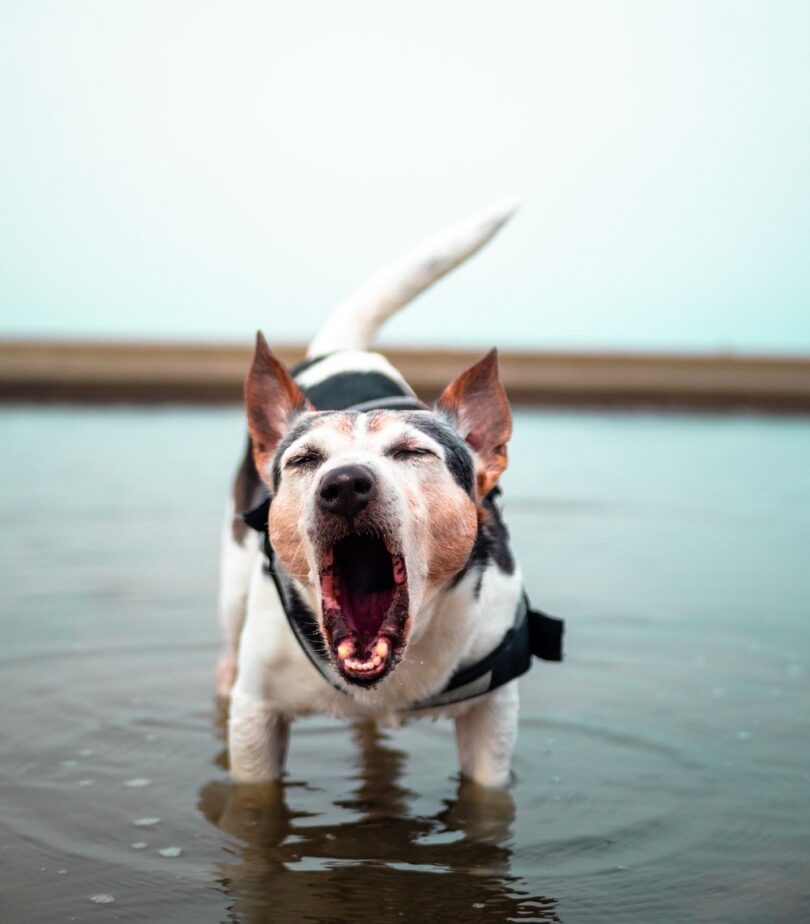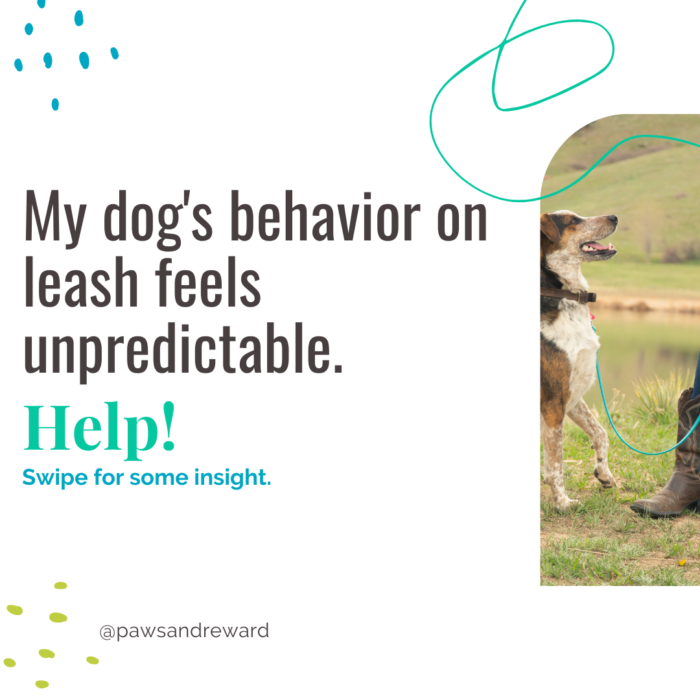In today’s episode of the Paws & Reward Podcast, I have the pleasure of interviewing Rachel Laurie Harris of A Good Feeling Dog Training in Denver CO about leash reactivity in dogs.
We talk about the many, necessary skills both the pet parent and the dog need in order to be successful in navigating this behavior concern.
Some of these skills include leash reactivity training mechanics, reading body language, staying connected during the walk, and teaching the dog to eat in the presence of scary stimuli.
And some of these skills (we think the most important ones) include self-love and compassion for both you and your dog, especially during moments of regression.
How are we defining leash reactivity in dogs?
When we refer to leash reactivity in this episode, we are describing a dog that is barking, lunging, pulling at the sight of other people, dogs, bikers, and/or anything that is a perceived threat in the eyes of the dog.
Most of the things that dogs react to can sometimes seem unreasonable to us. That person is walking away from you! Why are you barking your head off? That trash can didn’t even move! Why are you losing your mind?
However, it’s not up to us. The dog is having his or her emotional experience about something in the environment and being pushed over their emotional threshold.
Our job is not to get upset with them at that moment, our job is to help them through that hard time. When it comes to leash reactivity training, this is one of the most important roles that the pet owner plays.
Rachel and I get it….this is hard for us too, since we’re having our own emotional reaction at the dog’s behavior. However, if we both get upset about leash reactivity in dogs, then we both spiral out of control.
“Your dog is going to go over threshold, you don’t need to go over threshold with them.” – Rachel
Important Skills for the Human Dealing with Leash Reactivity in Dogs
If you’re struggling with leash reactivity in dogs, it’s important to not just address the dog’s behavior but your own human behavior as well. One of the most important steps toward successful leash reactivity training is to focus on building your own skills to handle the situation.
Some important skills for pet owners include:
Looking at the situation objectively and reading your dog’s body language
You can do this by filming your leash reactivity training sessions to watch both your behavior and your dog’s behavior objectively. Check out dax_theangrydog on Instagram for videos of reactivity training. She has a chest phone holder that captures great video!
Environmental awareness
Leash reactivity in dogs is often tied to specific triggers or situations. Know your dog’s triggers in their environment so you can proactively avoid them or prepare to calmly address them.
- Which fences have dogs behind them that set your dog off?
- What areas of your neighborhood are too hard for your dog to walk in?
- What situations cause you to react poorly to the situation? How can you support yourself on these walks?
- Do you have an exit strategy?
- Can you create the right amount of distance from the stimulus for training?
Click on the image below for more information!
Important Leash Reactivity Training Skills for the Dog
Human behavior is important when dealing with leash reactivity in dogs, but of course, the dog always plays a role. Some of the best skills to focus on for a dog struggling with leash reactivity include:
Fluently eating outside before we even start training
How can we arrange the environment so that the dog feels safe enough to eat?
What are some creative solutions to set up a successful training environment?
If the neighborhood is too hard to train in (your dog is not responding to training, not eating, hyper-vigilant) try doing leash reactivity training setups in these places:
- On balconies
- Front of the house, duck into the house for an exit strategy
- Apartment building hallways, duck into the apartment for an exit strategy
- Garage
- Drive to other locations
Attention walking
Attention walking focuses on marking and reinforcing the dog for checking in with you and walking near your side to stay connected on the walk! It’s way easier to interrupt leash reactivity in dogs if you and your dog were already connected before the trigger appears.
More Resources to Deal with Leash Reactivity in Dogs
If you’re ready to manage your dog’s leash reactivity once and for all, then check out Rachel’s Reactive Redefined Program or explore her website for more resources on reactive dogs.
For more information about improving the connection between you and your dog and managing a variety of dog training issues, review these resources from Paws and Reward:
- Podcast Episode #1: Self Care During the Dog Training Process
- Podcast Episode #4: Nonviolent Communication with Dogs
- Guide: The Six Connection Principles for Dogs & Owners
- Course: Connected Walks for Dogs & Owners


